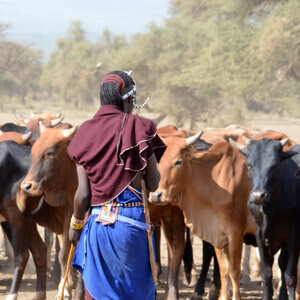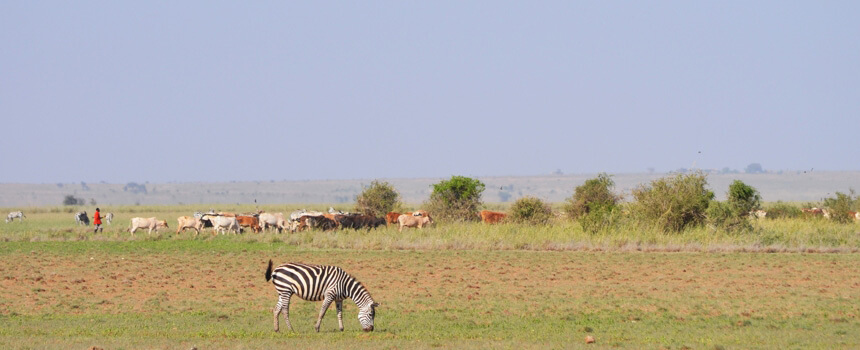 Feed for times of drought
Feed for times of drought
Grazing land for Maasai cattle in southern Kenya
Wide savannah, acacia trees, zebras, giraffes and lions: The typical images that people think of when they think of Kenya, and what attracts hundreds of thousands of tourists to the East African country every year. The Maasai as a population group belong to this landscape and live in the south of Kenya. Many know the Maasai for their red scarves and the strikingly colourful jewellery in the form of chains, bracelets and earrings. What very few people know: The land on which the wild animals live, on which lodges stand and safaris happen, traditionally belongs to the Maasai and is community property. Today, huge areas of the land are designated as nature reserves. Often, foreign investors also set up private nature reserves and build accommodation on Maasai land. Due to this development and the difficult climatic conditions, it is increasingly difficult for the Maasai to live off the land.
Necessity
Grass banks and hay stores for Maasai cattle during droughts
Activity
A local NGO provides Maasai communities with seeds, advises them on choosing land, trains them in cultivation, harvesting and management of the grass banks.
Countable effort
Number of newly sown and sustainably protected hectares of land for grass banks.
Result
Creation of emergency reserves of animal fodder for times of drought to reduce mortality among cattle.
Systemic effect
Improved chances of survival for the herds by creating fodder stores and thus better food security for the Maasai.
Background
Most Maasai still live traditionally as semi-nomadic pastoralists. The dry savanna does not permit agriculture even under the best conditions. The meat, milk and blood of their cattle provide the basis for food and income. The entire way of life of the Maasai revolves around the herds. They are extremely dependent on sufficient rainfall to grow enough grass for the animals. Today, however, every three to five years, between two and three consecutive rainy seasons will fail. The consequences of drought, overgrazing and deforestation in combination with climate change lead to progressive desertification. While 20 years ago it was still possible for cattle herders to leave the ancestral lands and move their animals as far as Tanzania or Central Kenya to graze and in search of water sources, this is no longer possible today. The reasons for this are the privatisation of land and the expansion of industrial areas. Since the Maasai families are dependent on their animals, drought and limited habitat result in serious problems. The Maasai are no longer able to feed themselves and are increasingly becoming recipients of food aid. In addition, there is a lack of knowledge about management practices and tourism.
The good deed
Grass banks will be set up on around 50,000 hectares of Maasai land to safeguard the livestock of the Maasai even in times of drought. The good deed will help to sow grass suitable for the climate in protected areas and subsequently keep the areas free of livestock. Hay will be made regularly and stored. At the same time, areas for livestock, especially dairy cows and calves, are made available if there is a lack of fodder. These grass banks will thus sustainably reduce the mortality rate of the animals. In addition, the Maasai are trained to make better use of their existing resources. The grass banks are part of a large-scale project to develop organic farming, access to water, livestock marketing, sustainable pasture management techniques and the establishment of nature reserves.

AboutKenya
Nairobi
46 790 758
2.961
142
Nairobi is the only city in the world that has a national park within its boundaries. It also is the home of one of the world’s largest slums, Kibera.
About the organization and further information
Zukunftsstiftung Entwicklung bei der GLS Treuhand e.V.
Website
https://www.zukunftsstiftung-entwicklung.de
Further information and source
- Bartholomäus Grill, 2009. Hilferufe aus aller Welt, Der Durst der Kühe, Zeit Nr. 50 2009.
- Fischer, Lars, 2017. „Warum der Hunger zurück nach Afrika kommt“, Spektrum.
- Justus Wanzala, 2016. As pastoralist land shrinks, Maasai women take livestock lead, Reuters.
- Fischer, Lars, 2017. „Warum der Hunger zurück nach Afrika kommt“, Spektrum.
- Justus Wanzala, 2016. As pastoralist land shrinks, Maasai women take livestock lead, Reuters.
- Bartholomäus Grill, 2009. Hilferufe aus aller Welt, Der Durst der Kühe, Zeit Nr. 50 2009.




